Top risks in automotive manufacturing: Protect your workplace and team with these safety resources
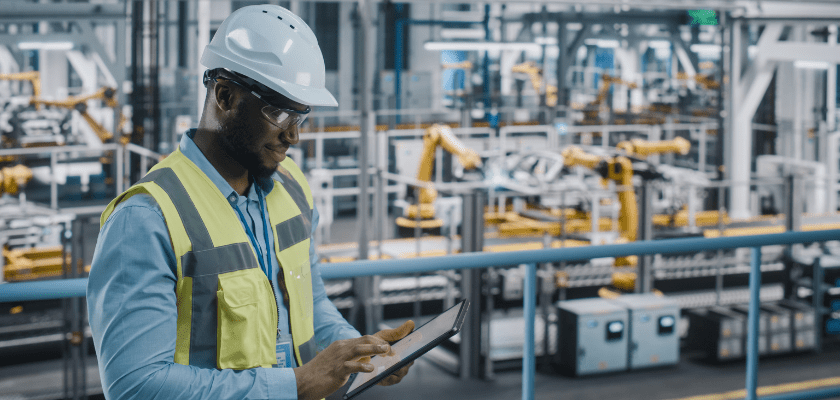
Workplace Safety & Prevention Services (WSPS) is a not-for-profit occupational health and safety association committed to ensuring every worker goes home healthy and safe at the end of the day. As your dedicated health and safety association for the automotive manufacturing industry, we are here to help with resources and support.
The automotive industry and partners are working with WSPS to develop solutions that address the top risks in this sector. In a recent study, this group identified the top 10 risks in the automotive manufacturing industry. Find out what these risks are and how you can protect your business with these resources below.
Top 10 risks in automotive manufacturing: Resources and training
Click on a risk to learn more and access health and safety resources and training.
- Exposure to hazardous energy during regular operations - machine safety and lockout/tag out
- Noise exposure
- Musculoskeletal disorders (MSDs) - forceful motions, awkward postures, repetitive motion
- Psychologically unsafe workplace resulting in mental stress
- Pedestrian contact with mobile equipment (forklift, tow motor, etc.)
- Ineffective contractor management
- Exposure to hazardous energy during troubleshooting, maintenance
- Mobile equipment operation
- Contact with press (struck by/caught in)
- Poor interior housekeeping leading to slips and trips
Have health and safety questions? We're here to help. Contact us at 1-877-494-9777 or fill out this form and a member of our team will contact you soon.
Machine safety and lockout/tag out
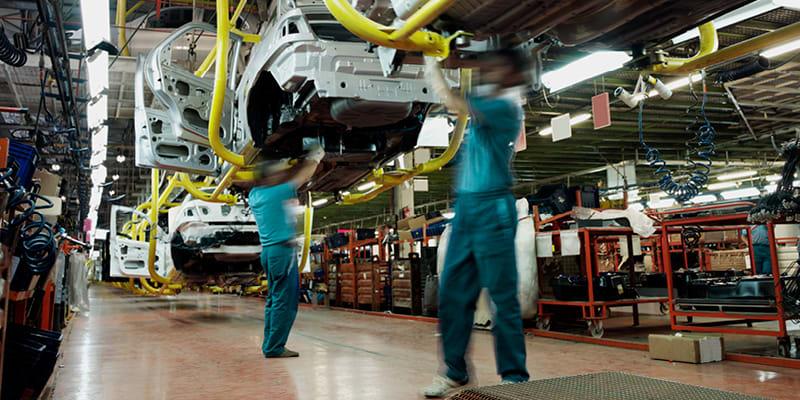
The automotive manufacturing industry exposes workers to many types of hazardous energy including mechanical, electrical, pneumatic, and kinetic.
If machines aren't properly safeguarded or locked out during maintenance, workers can suffer serious injuries, including amputations or even death, leading to significant costs for employers.
To prevent these risks, employers should:
- Review machine guarding
- Conduct pre-shift inspections
- Implement a clear lockout program
- Continuously measure program effectiveness
All safety procedures and programs should also clearly outline supervisor and worker responsibilities, include proper training, and refer to any applicable legislation and standards.
Resources
- Protect your team from the top hazard in automotive manufacturing: Tips to prevent exposure to hazardous energy (article)
- Safety Check: Power Press Safety (guide)
- Electric Vehicles Introduce New Hazards for Automotive Businesses (article)
- Lockout/tagout - Staying Safe with Hazardous Energy Guides (Printable PDF) - Learn lockout tagout best practices and how to reduce risks for each role in the workplace. These guides are available for employers, supervisors and workers.
- Staying safe with hazardous energy: Using the lockout/tag out procedure (video)
- Safety in 60 Seconds: Safety tips on lockout/tag out (video series)
- Lockout/tag out: Do it right with these expert tips (article)
- Lockout/tag out Training Guide (guide)
- Lockout/tag out: How to identify a machine's energy sources, and when to use the ‘Left-Hand Rule" (article)
- Protect your team from the top hazard in food manufacturing: Tips to prevent lockout/tag out incidents (article)
- Effective lockout training: 9 proven ways to get workers listening and learning (article)
- NEW! Pre-Start Health and Safety Review (PSR) Checklist for New Equipment
- NEW! Pre-Start Health and Safety Review (PSR) Checklist for Modified Equipment
- NEW! Pre-Start Health and Safety Review (PSR) Frequently Asked Questions
Training and consulting
- Lockout/Tag out (eCourse, 1 hour)
- Lockout/Tag out Safety Essentials (online, instructor-led, 0.5 day)
- Managing Machine Safety (Online instructor-led training, 4 hours)
- Electrical Hazards (eCourse, 1 hour)
- Safeguarding of Machinery: Understanding & Applying CSA Z432 (Online instructor-led training, 1 day)
- Robot Safety: Decoding and Applying CSA Z434 (Online instructor-led training, 1 day)
- Machine Safety & Robotics Consulting - WSPS machine safety and robotics experts can improve your understanding of the hazards and their associated risks in your workplace. We will work with you to identify effective safeguarding options to protect worker safety.
Noise Exposure
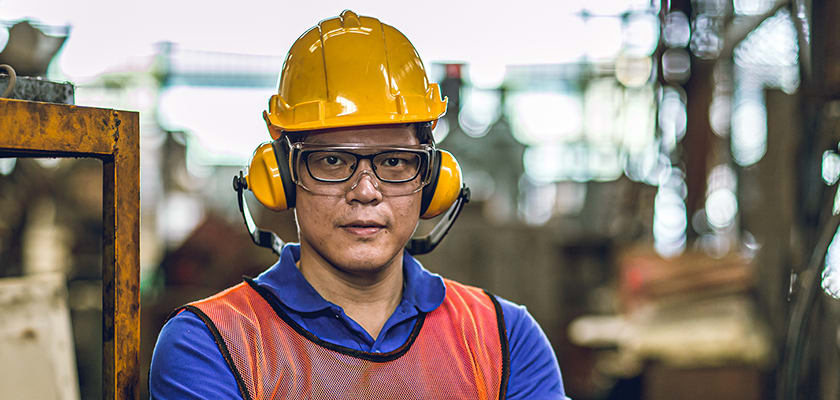
Vehicle manufacturing can produce excessive noise. Effective controls are needed to prevent long-term health effects and ensure communication methods are suitable. Prolonged exposure to loud noise can cause permanent hearing damage, such as tinnitus or hearing loss. Noise can disrupt communication, concentration, and mask warning signals, potentially leading to injuries and incidents. The physical and psychological stress from noise can also reduce productivity.
To keep workers safe, workplaces should conduct noise level assessments and implement protective measures. A thorough hearing conservation program includes regular noise monitoring, worker education, and audiometric testing (hearing tests) to track health over time.
Resources
- Noise apps: what you need to know (article)
- Why we need to be more noise aware (article)
- Noise-induced hearing loss is preventable (article)
- #AvoidNoise - how to prevent hearing loss in the workplace (article)
- Protect workers from chemical-related hearing loss with these 4 best practices (article)
- Archived Webinar - WSPS Safety Connection - Noise Awareness (webinar)
Training and consulting
- Noise in the Workplace (1 hour, eCourse)
- Connect with an occupational hygiene consultant to help you carry out noise assessments or build your hearing loss prevention program.
Musculoskeletal disorders

Automotive manufacturing workers often do repetitive tasks and handle heavy machinery, which can cause strain and injury. Poor workstation design and awkward postures add to the risk of musculoskeletal disorders (MSDs). MSDs are different aches and pains affecting the musculoskeletal system (muscles, tendons, and nerves) and make up almost half of all compensation claims in Ontario. Common MSDs include back pain, carpal tunnel syndrome, and tendonitis. Untreated MSDs can result in lifelong disabilities.
Employers face high costs for medical treatment and compensation, plus decreased productivity due to absenteeism. Ergonomic assessments, worker training, and automation and assistive technologies help address these challenges.
Resources
- Safe lifting: 10 tips and videos of how to lift properly (article)
- How to eliminate 3 hidden causes of musculoskeletal disorders (MSDs) (article)
- Back to basics: Answers to your questions about manual material handling and MSDs (article)
- How to identify and prevent repetitive strain injuries (article)
- MLITSD material handling inspections on now: be prepared (article)
- Safety Tips - Manual Material Handling and Safe Lifting (video series)
- Musculoskeletal Disorders (video)
- Job Aid - Vehicle Lifting Devices
- MSD Risk Assessment (guide)
- MSD Hazards Checklist
- Business in Motion: Managing Material Handling Hazards (guide)
- Manual Material Handling and Musculoskeletal Disorders (MSDs) Job Aid
- MLITSD Material Handling Inspections - Frequently Asked Questions
- Hand Pallet Trucks and Pump Trucks Job Aid
- Safe Lifting / Preventing musculoskeletal disorders or MSDs
- Non-motorized Material Handling Equipment Checklist
- MSD Prevention Guideline for Ontario (CRE-MSD)
- Guidelines for Supervisors - Ensuring Safe Lifting and Manual Material Handling in the Workplace Information Guide
- Manual Material Handling - Mobile Ladder Stands or Mobile Ladder Platforms checklist
- Safe Lifting Observer's Checklist
- Ergonomics in the workplace: understanding the law (Ministry of Labour, Immigration, Training and Skills Development)
Training and consulting
- Manual Materials Handling (eCourse, 1 hour)
- Safe Lifting & Manual Materials Handling (1/2 day, online instructor-led training)
- Safe Lifting & Manual Materials Handling - Supervisor (1 hour, online instructor-led training)
- Manual Materials Handling (1 hour, eCourse)
- Musculoskeletal Disorders (MSD) Prevention Awareness (1 hour, eCourse)
- Ergonomics Consulting - WSPS experts will work with you and your staff to find personalized, cost-effective solutions to improve your work environment, protect your employees and your bottom line.
Healthy Workplaces: Mental Health and Wellness
The automotive manufacturing industry can be demanding and unpredictable, causing mental stress for workers. Poor mental health can lead to physical symptoms like headaches and psychological issues like depression, fatigue, and anxiety, resulting in more sick days, difficulty concentrating, increased incidents, and lower productivity.
Creating a healthy workplace with a positive culture, physical environment, employee well-being, psychological safety, and community involvement shows commitment to workers' overall well-being, reduces risks and costs, and enhances competitive advantage.
Maintaining worker health and safety can be achieved through effective workplace policies, strong communication and training, and fostering an inclusive environment.
Resources
- De-escalating high-stress situations at work: 4 stages to aggression, 4 responses (article)
- What to do when domestic violence enters your workplace (article)
- 6 expert tips to support people after a traumatic workplace event (article)
- Take a trauma-informed approach to workplace violence and harassment (article)
- Small Biz Bytes: Workplace Violence and Harassment (video)
- WSPS Workplace Violence and Harassment Toolbox (guide)
- Workplace Harassment Policy (template)
- Reporting Form - Workplace Violence and Harassment Procedures (template)
- Workplace Harassment Investigations in Small Businesses: Tips for Employers (guide)
- Leveraging psychological safety to improve worker retention (article)
- Poor Workplace Mental Health is Costing Your Business Money (Trusted Leader Blog)
- Why encouraging vacation increases productivity and job satisfaction (article)
- Do your managers know how to create a psychologically safe workplace? (article)
- Visit the Mental Harm Prevention Roadmap site to create and implement a psychological health and safety strategy at your workplace.
- Guide for managing the risk of fatigue at work (Safe Work Australia)
Training and Consulting
- Violence and Harassment Prevention: Situational Awareness and De-escalation (Online, Instructor-Led Training, 4 hours)
- Mental Health First Aid (9 hours, virtual or in-person)
- Workplace Violence & Harassment Training (eCourse)
- Psychological Health and Safety Awareness (eCourse, 20 minutes)
- Psychological Health and Safety for Workers (eCourse, 1 hour)
- Harassment and Violence Prevention for Employees (eCourse, 1 hour)
- Leading for Psychological Safety in Challenging Times (Online Instructor-Led Training, 1 day)
- Stress in the Workplace (eCourse, 1 hour). Also available in French.
- Workplace Mental Health: How Managers Should Respond (Online Instructor-Led Training, 4 hours)
- Workplace Mental Health: What Health and Safety Committees Should Know (Online Instructor-Led Training, 1 day)
- Reducing Mental Health Stigma in the Workplace (eCourse, 30 minutes)
- Consulting - Connect with WSPS experts to develop a healthy workplace program or a violence, and harassment prevention program.
Mobile Equipment
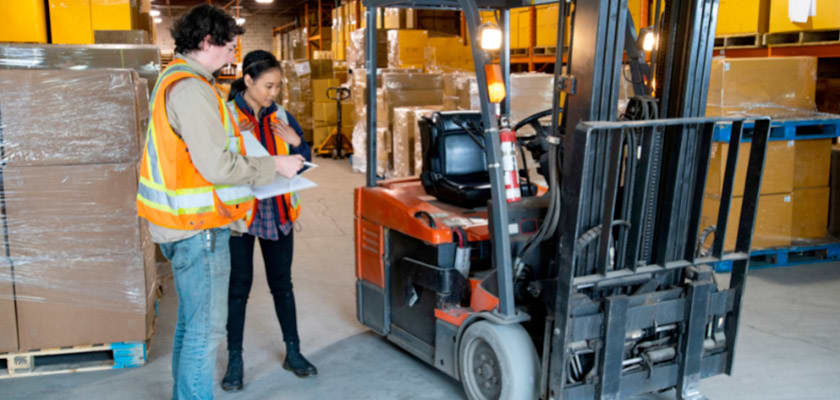
As automation and consumer demand grow in the automotive manufacturing industry, space constraints have become a problem in shared workspaces. Pedestrians, mobile-powered equipment, and vehicles working in a dynamic environment create a high-risk scenario. Collisions between mobile equipment and pedestrians, or between mobile equipment and fixed structures, can lead to severe or life-threatening injuries.
An organized workplace, with defined traffic flow, safe work procedures, training and supervision can reduce the risk of collisions and worker injuries, increase productivity, and have a positive impact on the bottom line.
Resources
- 8 steps to keep lift truck operators and pedestrians safe (article)
- 6 steps to implement a traffic management plan (article)
- Pedestrian Safety guides for employers, supervisors, and workers.
- Warehouses - Traffic Management & Pedestrian Safety (pre-recorded webinar)
- Worker resources: Safety around forklifts, cars, vans and trucks (video or article)
- Safety in 60 Seconds: What are the fundamentals of a strong traffic management assessment and program? (video)
- Vehicle & Pedestrian Safety (video)
- Pedestrian Safety & Traffic Management (guide)
- Mechanical Material Handling Q&A: Your questions answered (article)
- Protect warehouse workers from struck by incidents: Real life examples and expert tips (article)
- Prevent struck by incidents: 3 expert tips to keep workers safe (article)
- 8 tips for managing external traffic
- Nip point incident offers 6 lessons for workplaces (article)
- Inspecting robot systems: 7 ways to boost JHSC performance (article)
- Worker Resource: Loading and Unloading Trailers Safely (article and video)
- Safety in 60 Seconds: Safety tips - What should employees know about loading and unloading a truck or trailer safely? (video)
- Warehouse Safety Tips - Assess Your Warehouse Risks (video)
- Loading Docks and Warehouses (guide)
- Guide to workplace traffic management (Safe Work Australia)
- Reducing the risk of workers being struck by vehicles or mobile equipment: Guide to using the fillable template (WorkSafe BC)
Safety Checklists
- Working Around Traffic
- Visibility Hazards Checklist
- Reach Truck/Order Picker Safety
- Storage Rack Safety
- Forklift Safety Check
Training and Consulting
- Inspecting & Maintaining Steel Storage Racks (Online Instructor-Led Training, 1 day)
- Warehouse, Distribution, & Racking Health and Safety Consulting - WSPS consultants can help you identify risks, train your staff and improve your warehouse and distribution environment, protecting your people and bottom-line. This could include health and safety program development support, pedestrian safety and traffic management planning, racking safety and more. Connect with a consultant.
Contractor Management
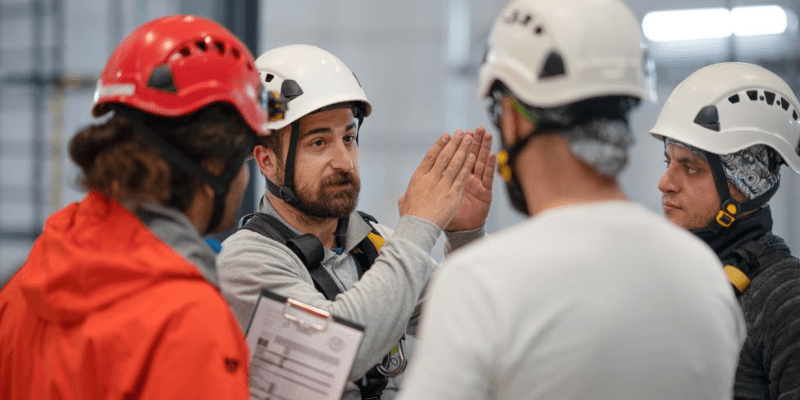
As the automotive manufacturing industry expands, the need for third-party contractors has increased. Contractors are often hired for high-risk tasks, which can expose workers to additional risks if not properly identified, controlled, and communicated.
Effective contractor management involves a system of controls to ensure that contracted services support safe facility operations. Identifying potential and actual risks before contractors arrive on site is crucial to a successful program. The entire lifecycle of the contract should be addressed, including communication measures in the event of a near-miss or incident.
Resources
Training
- Hiring and Managing Outside Contractors (1/2 day, Online Instructor-Led Training)
- Construction in Industrial Establishments (1/2 day, Online Instructor-Led Training)
- Contractor Health and Safety Training (1 hour, eCourse)
- Construction in Industrial Establishments (1/2 day, Online Instructor-Led Training)
- Connect with a WSPS expert to find out if you have gaps in your health and safety program regarding outside contractors.
Slips, trips and falls
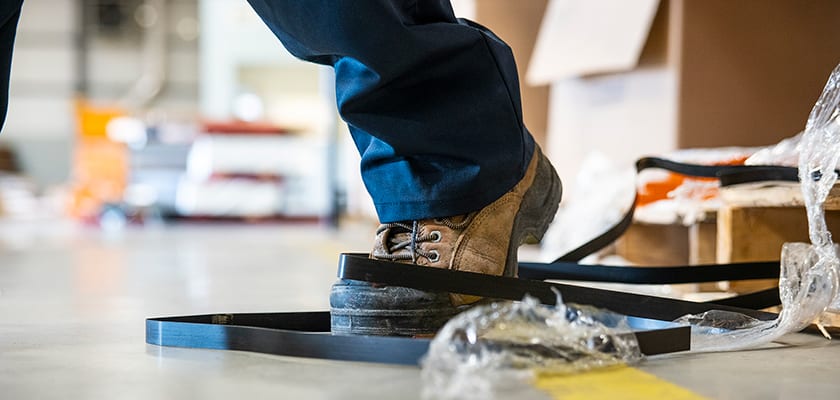
While they may seem harmless, slips, trips and falls are some of the most common causes of workplace injuries. A slip or fall can cause severe injuries, including sprains, strains, bruises, broken bones, back injuries, concussions, contusions, abrasions, and lacerations. A good housekeeping program, including quick spill clean-ups, can help reduce the risk of injury.
Working at heights, including the use of ladders and mobile access platforms, can also pose significant risks in the workplace. Develop effective work plans, policies, and programs with input from key stakeholders, including workers. This collaboration ensures safe practices are developed, applied, and maintained, which is critical for reducing risks.
Resources
- Stop slips, trips and falls with these expert tips (article)
- Falls from under 3-metres can be fatal: how to prevent them (article)
- Slips, Trips, and Falls Overview (article)
- Ladder Safety (guide)
- Safety Check: Mopping Spills Safety (guide)
- Safety Check: Step Ladder Safety (guide)
- Mobile Ladder Stands or Mobile Ladder Platforms (guide)
- Job Aid - Working at Heights
- Working at Heights Regulation and Information (article)
- Housekeeping Overview (article)
- Overview: Working at Heights Regulation and Information
- Preventing slips, trips, and falls in the workplace (Ministry of Labour, Immigration, Training and Skills Development)
Training
- Preventing Falls from Slips and Trips (1 hour self-paced eCourse)
- Ladder Safety Training (1 hour self-paced eCourse)
- Working at Heights (an Introduction) (1 hour, self-paced eCourse)
- Speak to a WSPS consultant about how to assess the risks of falls from heights and set up a fall protection program.
Connect with an expert
If you’re ready to get started, or simply have questions about our services or approach, contact a WSPS specialist to find out more.





